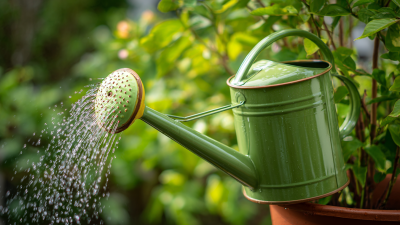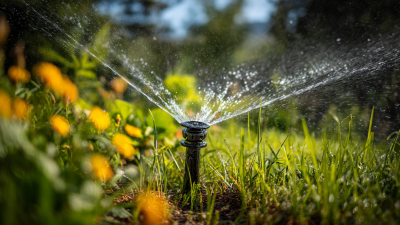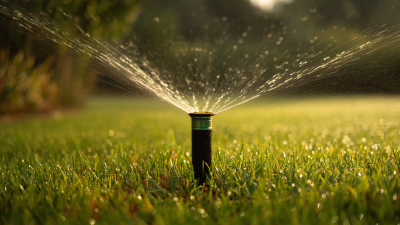 Choosing the right Garden Watering Tools is essential not only for maintaining plant health but also for promoting efficient water usage in gardens. According to a report by the Water Resources Institute, nearly 70% of freshwater withdrawals are allocated for agricultural irrigation, highlighting the critical need for effective watering practices. Moreover, the University of California's Agriculture and Natural Resources division has noted that well-chosen watering tools can reduce water consumption by up to 40%, all while ensuring that plants receive the moisture they require to thrive.
Choosing the right Garden Watering Tools is essential not only for maintaining plant health but also for promoting efficient water usage in gardens. According to a report by the Water Resources Institute, nearly 70% of freshwater withdrawals are allocated for agricultural irrigation, highlighting the critical need for effective watering practices. Moreover, the University of California's Agriculture and Natural Resources division has noted that well-chosen watering tools can reduce water consumption by up to 40%, all while ensuring that plants receive the moisture they require to thrive.
With a variety of options available—from drip irrigation systems to smart hoses—understanding how to select the best tools tailored to your garden's specific needs can dramatically impact both the ecological footprint and the overall success of your gardening efforts. By integrating technology with user-friendly designs, modern Garden Watering Tools empower gardeners to optimize their watering regimes for sustainable practices and healthier plants.
When it comes to maintaining a healthy garden, choosing the right watering tools is essential for optimizing water usage and promoting plant health. There are several types of watering tools available, each suited for specific gardening needs. For instance, hosepipes are versatile and ideal for larger areas, while watering cans are perfect for targeted watering, especially for potted plants or delicate seedlings. Drip irrigation systems stand out as an efficient choice for conserving water, delivering moisture directly to the roots of plants without wastage.
Tips: When selecting watering tools, consider your garden's size and layout. For small gardens or container plants, opt for a precisely designed watering can to avoid over-saturating the soil. For larger spaces, an adjustable nozzle on a hosepipe can help control the water flow effectively. Moreover, integrating a rainwater collection system can enhance water efficiency and nourish your plants with chemical-free moisture.
Understanding the purpose of each tool allows gardeners to use them optimally. Soaker hoses are particularly advantageous for watering rows of plants evenly without disturbing the soil, while spray nozzles offer flexibility in varying water pressure and patterns. By selecting the right tools and employing these strategies, gardeners can ensure their plants receive just the right amount of water necessary for thriving growth.
 When selecting garden watering tools with a focus on water efficiency, there are several key features to consider. First and foremost, the water flow rate is essential; tools designed to deliver a consistent flow allow for better control over how much water each plant receives. Drip irrigation systems are particularly effective, as they provide water directly to the plant roots, minimizing evaporation and runoff. Additionally, adjustable nozzles can help tailor the spray pattern and flow rate, enabling gardeners to conserve water by targeting specific areas.
When selecting garden watering tools with a focus on water efficiency, there are several key features to consider. First and foremost, the water flow rate is essential; tools designed to deliver a consistent flow allow for better control over how much water each plant receives. Drip irrigation systems are particularly effective, as they provide water directly to the plant roots, minimizing evaporation and runoff. Additionally, adjustable nozzles can help tailor the spray pattern and flow rate, enabling gardeners to conserve water by targeting specific areas.
Another important aspect to evaluate is the material and construction of the watering tool. Durable materials reduce the likelihood of leaks, which can waste precious water. Moreover, tools with built-in timers or smart technology can further enhance water efficiency by automating watering schedules, ensuring that plants receive the right amount of water without overwatering. Finally, ergonomic designs can significantly improve user experience, allowing for longer periods of watering without fatigue, ultimately contributing to better overall plant health and sustainable garden practices.
When selecting the best watering tools for your garden, it is crucial to consider both the size of your garden and the specific needs of your plants. According to a report from the USDA, approximately 70% of residential water use during the summer months is dedicated to outdoor irrigation. This highlights the importance of efficient watering systems that not only conserve water but also promote optimal plant health. For small gardens, handheld watering cans or soaker hoses provide targeted hydration, minimizing water wastage and ensuring moisture reaches the roots where it is needed most.
In contrast, larger gardens may benefit from automated sprinklers or drip irrigation systems. A study by the Environmental Protection Agency (EPA) indicates that drip irrigation can reduce water usage by up to 60% compared to traditional sprinklers, while simultaneously improving plant growth and yield. For landscapes with diverse plant species, adjustable flow emitters in drip irrigation can be tailored to meet the varying moisture requirements of different plants, ensuring that every section of the garden receives adequate care. By matching your watering tools to the size of your garden and the specific needs of your plants, you can enhance both water efficiency and overall garden health.
 Maintaining healthy soil moisture is crucial for the vitality of your plants. One effective technique is implementing a
drip irrigation system which delivers water directly to the root zone. This minimizes surface evaporation and ensures that the moisture penetrates deeply into the soil, encouraging strong root development. Additionally, incorporating moisture-retentive materials, like mulch or compost, can greatly enhance soil structure and prevent rapid water loss.
Maintaining healthy soil moisture is crucial for the vitality of your plants. One effective technique is implementing a
drip irrigation system which delivers water directly to the root zone. This minimizes surface evaporation and ensures that the moisture penetrates deeply into the soil, encouraging strong root development. Additionally, incorporating moisture-retentive materials, like mulch or compost, can greatly enhance soil structure and prevent rapid water loss.
Preventing overwatering is equally important for plant health. To achieve this, one should regularly check the moisture levels in the soil using tools like soil moisture meters. These devices can help gauge when to water, ensuring plants are neither overly saturated nor parched. Timing is essential; watering early in the morning or later in the afternoon can help reduce evaporation and maximize water absorption. By employing these techniques, gardeners can optimize water usage, promote healthier soil, and support the overall well-being of their plants.
Innovative technologies are essential for enhancing sustainable garden watering practices. One of the most significant advancements in this area is the integration of digital technologies for water use and management. These technologies provide real-time data on soil moisture levels, allowing gardeners to optimize their watering schedules and minimize waste.
Smart irrigation systems, driven by sensors and data analytics, can automatically adjust the amount of water supplied based on weather conditions and plant needs, fostering both efficiency and plant health.
Furthermore, the application of emerging wastewater treatment technologies contributes to a more sustainable water management strategy in gardening. Techniques such as decentralized wastewater systems can recycle water efficiently, supporting urban gardening initiatives and reducing reliance on traditional water sources.
By utilizing innovative methods, such as those showcased in the circular economy models, gardeners can enhance their practices, ensuring a resilient approach to water use while promoting the overall sustainability of their gardening efforts.






